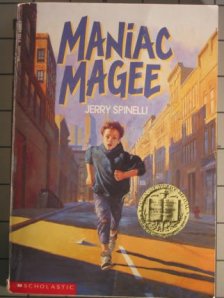 Maniac Magee was first published in 1990, and received the prestigious Newbery Medal in 1991. The National Education Association named Maniac one of its “Teachers’ Top 100 Books for Children” in 2007, the School Library Journal placed it among the “Top 100 Chapter Books” in 2012.
Maniac Magee was first published in 1990, and received the prestigious Newbery Medal in 1991. The National Education Association named Maniac one of its “Teachers’ Top 100 Books for Children” in 2007, the School Library Journal placed it among the “Top 100 Chapter Books” in 2012.
That’s pretty high praise, suggesting the book’s endurance and strength over 20 years. Reading it for the first time in 2014, I wished I had read it when my children were in elementary and middle school. We could have talked about the magic realism that works well in the novel: Maniac’s powers to run, to hit homeruns, and to untie huge tangled knots. Those powers seem to serve Maniac (real name Jeffrey Lionel Magee) well after his parents die in a tragic accident when he’s 3 years old. He runs away after 8 years with his angry aunt and uncle, and ends up in Two Mills, Pennsylvania. He doesn’t realize, at first, how racially divided the town is. Maniac is white, and one of his first and best friends is Amanda Beale, a black girl who treasures books, and whose family takes him in for a short time. His football interceptions and his fearlessness entering a scary backyard build him a reputation among both black and white children as a “maniac.”
Much of the book is about Maniac’s search for a sense of home, as racial and other incidents cause him to keep moving, and make him wonder if he is causing problems for people he cares about. He becomes friends with a washed up minor league baseball player. Maniac teaches Grayson to read and celebrates a sweet Christmas with him. He tries to help a couple of rowdy little brothers stay in school. He eventually ends up homeless again, living in the buffalo pen at the zoo. After one more challenging adventure, Maniac finds his way back to the Beale family.
The themes of racism, illiteracy, and homelessness, plus the blend of an orphan’s magical talents (including his ability to travel long distances and not attend school) provide lots to talk and think about. The 46 (short) chapters are appropriate for third to ninth graders. Social media and electronic devices may have changed a lot in the last two decades, but this story of a child figuring out his way in the world remains compelling.
Recommendation: Highly Recommended; ages 8-14
Reviewer: Maureen McCauley Evans
